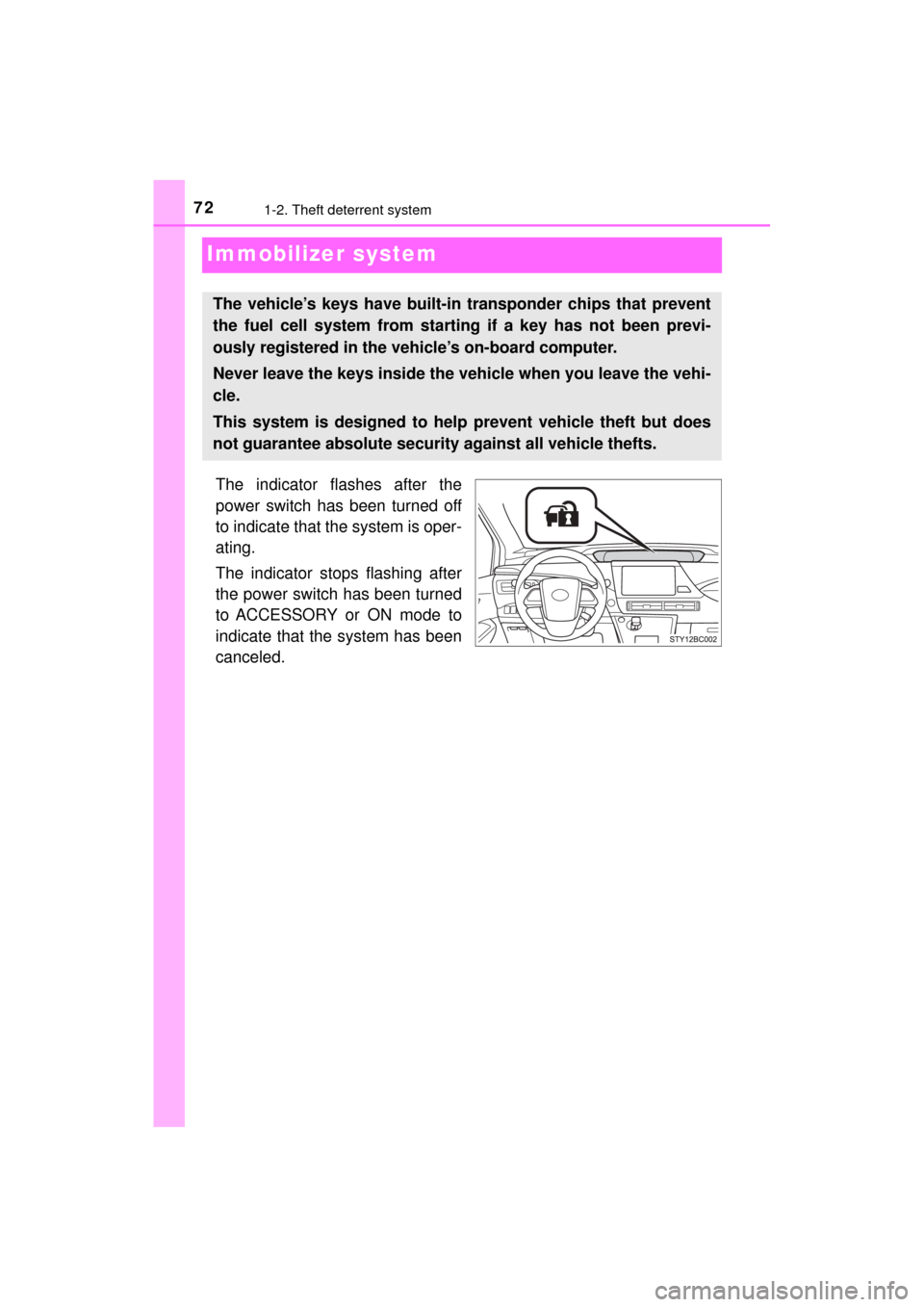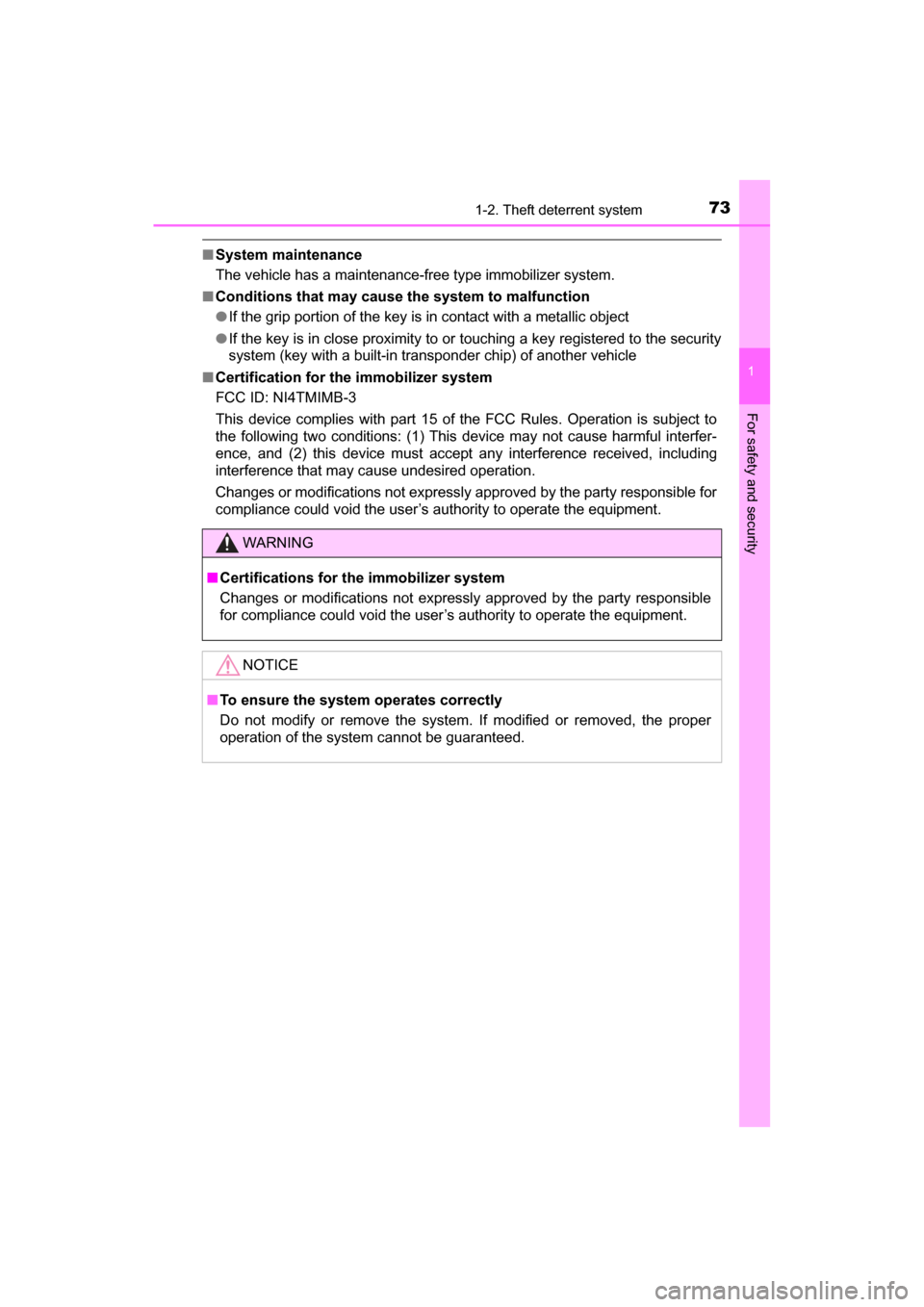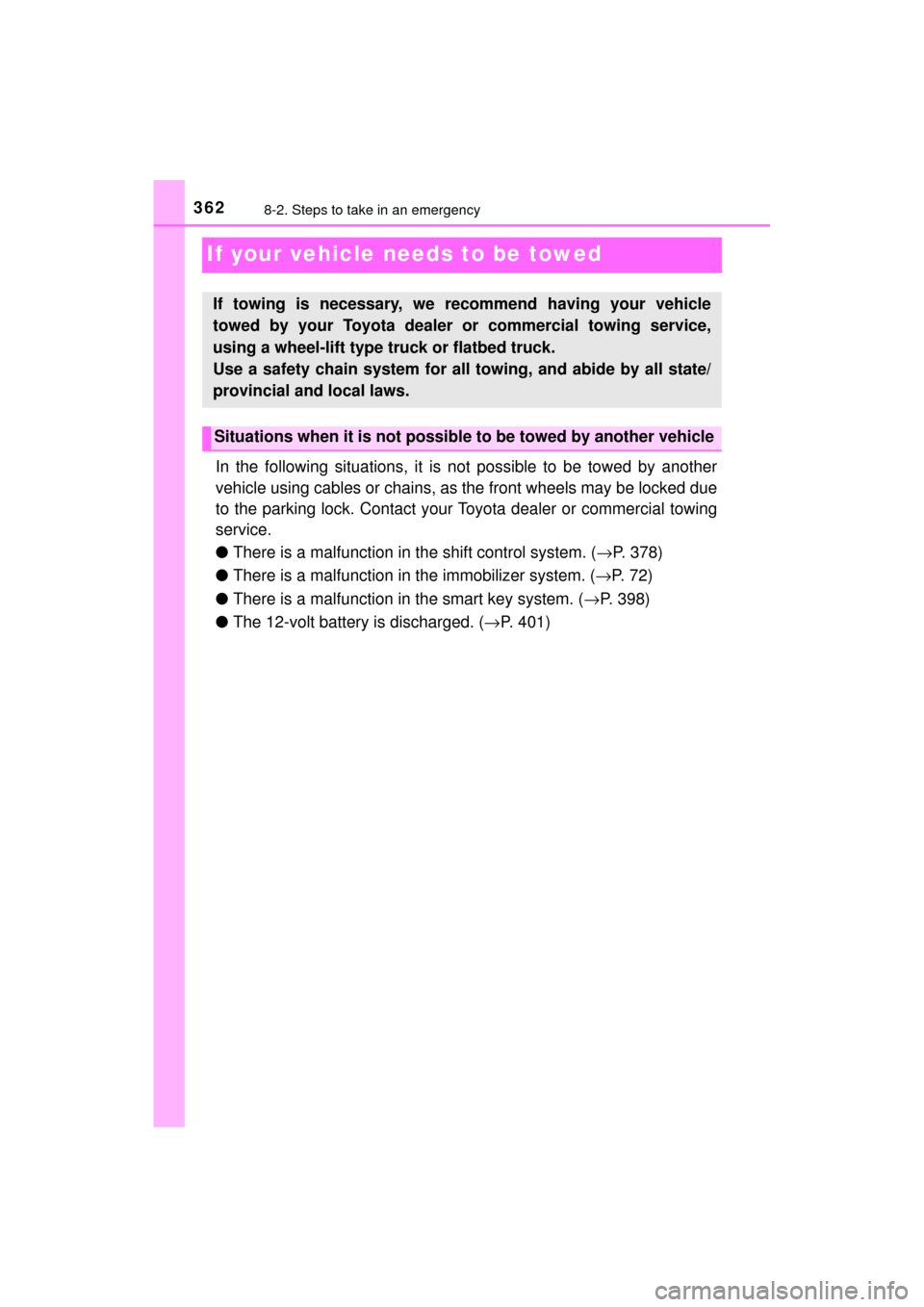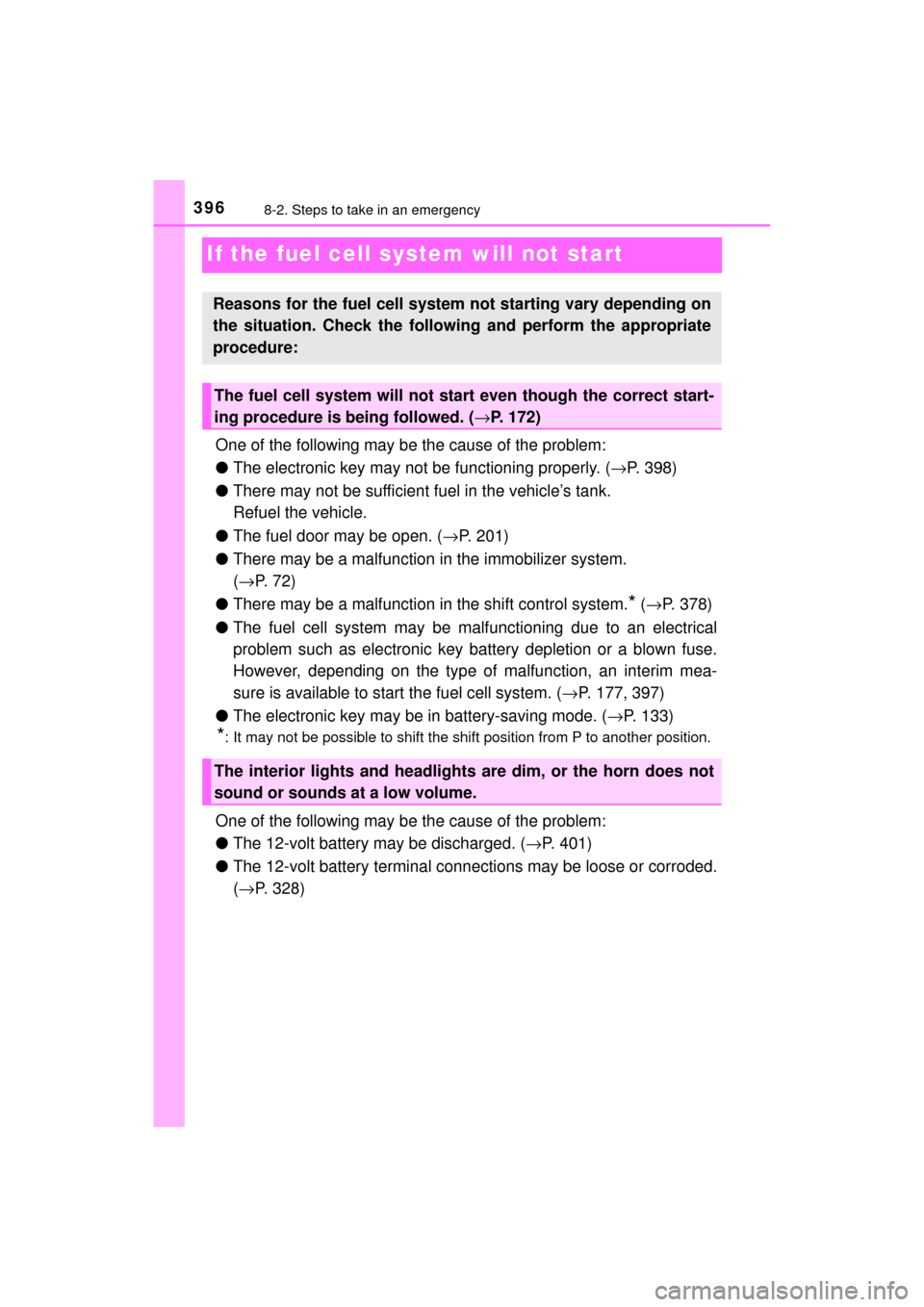2017 TOYOTA MIRAI immobilizer
[x] Cancel search: immobilizerPage 2 of 464

TABLE OF CONTENTS2
MIRAI_OM_USA_OM62023UFor your information....................... 6
Reading this manual .................... 12
How to search .............................. 13
Pictorial index .............................. 14
1-1. For safe use
Before driving ...................... 26
For safety drive ................... 28
Seat belts ............................ 30
SRS airbags ........................ 36
Front passenger occupant classification system ......... 49
Safety information for children ........................ 55
Child restraint systems ........ 56
1-2. Theft deterrent system Immobilizer system ............. 72
Alarm ................................... 74
Theft prevention labels ........ 76
2. Fuel cell vehicle Fuel cell vehicle characteristics ................... 78
Fuel cell vehicle precautions ....................... 82
Advice for driving fuel cell vehicles ............................. 94 3. Instrument cluster
Warning lights and indicators ........................... 98
Gauges and meters ........... 102
Multi-information display .... 107
4-1. Key information Keys................................... 116
4-2. Opening, closing and locking the doors
Doors ................................. 120
Trunk ................................. 126
Smart key system .............. 131
4-3. Adjusting the seats Front seats......................... 138
Driving position memory .... 140
Head restraints .................. 145
4-4. Adjusting the steering wheel and mirrors
Steering wheel ................... 147
Inside rear view mirror ....... 149
Outside rear view mirrors ............................. 151
4-5. Opening and closing the windows
Power windows.................. 154
1For safety and security
2Fuel cell system
3Instrument cluster
4Operation of each
component
Page 25 of 464

25
For safety and security1
MIRAI_OM_USA_OM62023U1-1. For safe use
Before driving ...................... 26
For safety drive ................... 28
Seat belts ............................ 30
SRS airbags ........................ 36
Front passenger occupant classification system ......... 49
Safety information for children ............................. 55
Child restraint systems........ 56
1-2. Theft deterrent system Immobilizer system ............. 72
Alarm................................... 74
Theft prevention labels........ 76
Page 72 of 464

721-2. Theft deterrent system
MIRAI_OM_USA_OM62023U
Immobilizer system
The indicator flashes after the
power switch has been turned off
to indicate that the system is oper-
ating.
The indicator stops flashing after
the power switch has been turned
to ACCESSORY or ON mode to
indicate that the system has been
canceled.
The vehicle’s keys have built-in transponder chips that prevent
the fuel cell system from starting if a key has not been previ-
ously registered in the vehicle’s on-board computer.
Never leave the keys inside the vehicle when you leave the vehi-
cle.
This system is designed to help prevent vehicle theft but does
not guarantee absolute security against all vehicle thefts.
Page 73 of 464

731-2. Theft deterrent system
1
For safety and security
MIRAI_OM_USA_OM62023U
■System maintenance
The vehicle has a maintenance-free type immobilizer system.
■ Conditions that may cause the system to malfunction
●If the grip portion of the key is in contact with a metallic object
● If the key is in close proximity to or touching a key registered to the security
system (key with a built-in transponder chip) of another vehicle
■ Certification for the immobilizer system
FCC ID: NI4TMIMB-3
This device complies with part 15 of the FCC Rules. Operation is subject to
the following two conditions: (1) This device may not cause harmful interfer-
ence, and (2) this device must accept any interference received, including
interference that may cause undesired operation.
Changes or modifications not expressly approved by the party responsible for
compliance could void the user’s authority to operate the equipment.
WARNING
■ Certifications for the immobilizer system
Changes or modifications not expressly approved by the party responsible
for compliance could void the user’s authority to operate the equipment.
NOTICE
■To ensure the system operates correctly
Do not modify or remove the system. If modified or removed, the proper
operation of the system cannot be guaranteed.
Page 134 of 464

1344-2. Opening, closing and locking the doors
MIRAI_OM_USA_OM62023U■
Conditions affecting operation
The smart key system uses weak radio waves. In the following situations, the
communication between the electronic key and the vehicle may be affected,
preventing the smart key system, wireless remote control and immobilizer
system from operating properly. (Ways of coping: →P. 398)
● When the electronic key battery is depleted
● Near a TV tower, electric power plant, gas station, radio station, large dis-
play, airport or other facility that generates strong radio waves or electrical
noise
● When the electronic key is in contact with, or is covered by the following
metallic objects
• Cards to which aluminum foil is attached
• Cigarette boxes that have aluminum foil inside
• Metallic wallets or bags
• Coins
• Hand warmers made of metal
• Media such as CDs and DVDs
● When other wireless keys (that emit radio waves) are being used nearby
● When carrying the electronic key together with the following devices that
emit radio waves
• Portable radio, cellular phone, cordless phone or other wireless commu-
nication devices
• Another vehicle’s electronic key or a wireless key that emits radio waves
• Personal computers or personal digital assistants (PDAs)
• Digital audio players
• Portable game systems
● If window tint with a metallic content or metallic objects are attached to the
rear window
● When the electronic key is placed near a battery charger or electronic
devices
Page 176 of 464

1765-2. Driving procedures
MIRAI_OM_USA_OM62023U■
Parking in cold temperatures
●Water may automatically purge from the tailpipe, even when the fuel cell
system is off, in order to prevent liquid in the fuel cell stack, hydrogen pipe-
lines, etc., from freezing while parked during cold temperatures.
● It is normal to hear hissing and other sounds during purge. ( →P. 80)
● The H
2O indicator on the meter will illuminate during purge.
● Before storing the vehicle for extended periods of time in a location with
freezing temperatures, perform a cold-weather manual purge:
Turn the power switch to ON mode and press the H
2O switch.
Check that the H
2O indicator on the meter turns on.
While depressing the brake, press the power switch to start the fuel cell
system.
Check that the “READY” indicator turns on.
Press the power switch to stop the fuel cell system.
The water release is automatically performed. During water purge, the
H
2O indicator turns on. (Longer than normal water purge)
■ Conditions affecting operation
→P. 134
■ Notes for the entry function
→P. 135
■ If the fuel cell system does not start
●The immobilizer system may not have been deactivated. ( →P. 72)
Contact your Toyota dealer.
● Check that the shift position is P. ( →P. 179)
The fuel cell system cannot be started when the shift position is N.
If P position is not selected, “Shift to P position to start” will be displayed on
the multi-information display.
● Check that the fuel door is closed.
When the fuel door is open, the fuel cell system cannot be started.
Close the fuel door before starting the system. ( →P. 201)
■ If “Smart Entry & Start System malf unction See owner’s manual” is dis-
played on the multi-information display
The system may be malfunctioning. Have the vehicle inspected by your
Toyota dealer immediately.
■ If the “READY” indicator does not come on
In the event that the “READY” indicator does not come on even after perform-
ing the proper procedures for starting the vehicle, contact your Toyota dealer
immediately.
■ If the fuel cell system is malfunctioning
→P. 376
1
2
3
Page 362 of 464

3628-2. Steps to take in an emergency
MIRAI_OM_USA_OM62023U
If your vehicle needs to be towed
In the following situations, it is not possible to be towed by another
vehicle using cables or chains, as the front wheels may be locked due
to the parking lock. Contact your Toyota dealer or commercial towing
service.
●There is a malfunction in the shift control system. ( →P. 378)
● There is a malfunction in the immobilizer system. ( →P. 72)
● There is a malfunction in the smart key system. ( →P. 398)
● The 12-volt battery is discharged. ( →P. 401)
If towing is necessary, we re commend having your vehicle
towed by your Toyota dealer or commercial towing service,
using a wheel-lift type truck or flatbed truck.
Use a safety chain system for all towing, and abide by all state/
provincial and local laws.
Situations when it is not possibl e to be towed by another vehicle
Page 396 of 464

3968-2. Steps to take in an emergency
MIRAI_OM_USA_OM62023U
If the fuel cell system will not start
One of the following may be the cause of the problem:
●The electronic key may not be functioning properly. ( →P. 398)
● There may not be sufficient fuel in the vehicle’s tank.
Refuel the vehicle.
● The fuel door may be open. ( →P. 201)
● There may be a malfunction in the immobilizer system.
( → P. 72)
● There may be a malfunction in the shift control system.
* (→ P. 378)
● The fuel cell system may be malf unctioning due to an electrical
problem such as electronic key ba ttery depletion or a blown fuse.
However, depending on the type of malfunction, an interim mea-
sure is available to start the fuel cell system. ( →P. 177, 397)
● The electronic key may be in battery-saving mode. ( →P. 133)
*: It may not be possible to shift the shift position from P to another position.
One of the following may be the cause of the problem:
● The 12-volt battery may be discharged. ( →P. 401)
● The 12-volt battery terminal connections may be loose or corroded.
(→ P. 328)
Reasons for the fuel cell system not starting vary depending on
the situation. Check the follo wing and perform the appropriate
procedure:
The fuel cell system will not start even though the correct start-
ing procedure is being followed. ( →P. 172)
The interior lights and headlights are dim, or the horn does not
sound or sounds at a low volume.